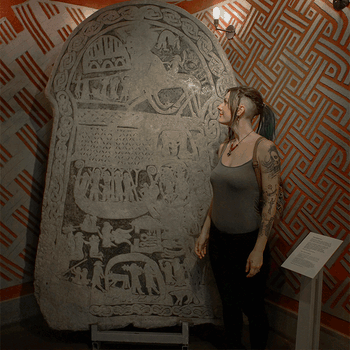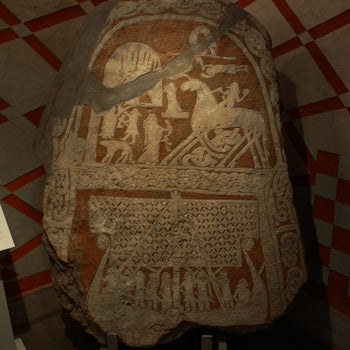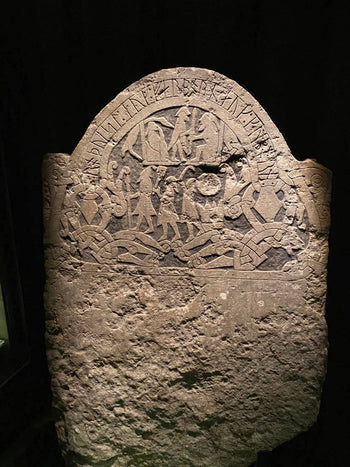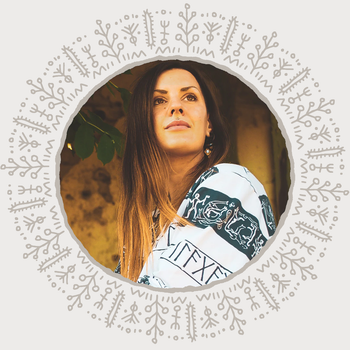Halls of the Norse Gods
← BackBesides the literary sources that can be found in the form of old poems, songs and the Eddas, there are a couple of archaeological artefacts that illustrate examples of the gods and their halls. Some of these artefacts are the picture-stones of Gotland, Sweden. They are dated around the year 400 A.D., which means they predate the majority of the thousands of runestones found around Scandinavia. These picture stones were made during the Scandinavian Migration Period and Vendel Era, hundreds of years before the Viking Age. An example of these picture-stones can be found below in this text, where it seems like Odin's Valhalla is depicted in the background next to Odin and Sleipnir, with its many doors, and a Wolf depicted next to a Valkyrie carrying mead horns.




where I see lay
where aesir and elves close are;
There in Trudheim
where Thor shall live
until the powers are pulled apart”
Grímnismál

Ullr has
his halls let built...”
Grímnismál

by the gods to Freyr
as a rich gift in the morning of tomorrow.”
Grímnismál

where kind gods
the halls with silver had covered;
Valaskalf built
with wisdom for self
in ancient times the aesir himself.”
Grímnismál
Valaskalf is a big hall covered with silver, and this is also the location of Odin’s tall throne Hlidskjalf. From Hlidskjalf Odin could see everything going on throughout the universe. It was said that when the storms blew over Midgard, that it was Odin moving above them while traveling to his tall throne. There also Odin’s loyal wolves Geri and Freki had their den, where Odin who didn’t need to eat, gave them all of the hall’s delicacies.
from over
cool waves roars;
Odin and Saga
there in forever
happily out of goldenbowls drink…”
Grímnismál
Sökkvabäck is the Hall of the goddess Saga (who is theorised to be Freyja by some), where it also seems like Odin occupies a lot since they’re said to feast there together forever. The only real knowledge we have of Sökkvabäck is that it is mentioned to be big according to Snorri. The name Sökkvabäck is thought to mean “the sinking stream”. Bäck still means stream in Swedish.
where the golden shimmering
Valhalla widely reaches.
There Ropt coaches
from struggle and battle
daily the warkilled.
Easily they see
who to Odin travel,
what a hall they all see:
the trusses are of spears,
the rood is of shields,
the benches are covered with chainmail.
Easily they see,
who to Odin travel,
what a hall they see:
wolf is hanging
west of the door,
and eagle above.”
Grímnismál
This is a couple of examples of the first mentions of the hall of Valhalla in this poem. We get to know that Valhalla is situated in the location of Gladsheimr. Gladsheimr is also according to Snorri where the male aesir hold their meetings, in a hall containing thirteen tall high seats. In old norse Gladsheimr translates into “bright home”. We also get to know in this poem that the outside of Valhalla is remarkable.
and yet another forty
I know on Valhalla exists;
Eight hundred einhärjar
against the wolf they walk,
all at once pull every door.”
Grímnismál
Here we get to know that Valhalla is huge and withholds a lot of Einhärjar, warriors of the slain that goes to Valhalla after they’ve fallen in battle. Eight hundred Einhärjar can walk through every door at once, that’s a lot of room to say the least.

where Tjasse lives,
very powerful jötunn.
Now Skadi is building,
maiden of the gods, the clean,
on her father’s ancient lands.”
Grímnismál

where Baldur have
his halls build
Oh that place,
where I know there is
but shy runes of misfortune.”
Grímnismál

where Heimdallr is said
over sanctuaries rule;
godwatcher drinks
in house of the joyous
cheerfully drinks his good mead”
Grímnismál

where Freyja decides,
how the seats in the halls is divided;
half of the choices
she chooses,
the other half is owned by Odin.”
Grímnismál

on a golden structure lays
the hall’s silver roof;
there lives Forseti,
who in forever peace
between the battling decides.”
Grímnismál

where Njordr has
his halls built…”
Grímnismál

and high grass
Vidar’s land, Vide;
there already sits
son upon horseback,
ready a father to avenge.”
Grímnismál

- Were I outside
as well as currently indoors,
out of the hall of Ægir,
carried your head
in my hand;
it seems suitable for your lie enough.”
Lokasenna
Best regards!
– Elin aka MooseLady
Just wanted to thank you for taking the time to put this together for members of our faith. It’s hard to find a kindred that’s serious about this stuff and, obviously, the examples left are incomplete at best and sometimes hard to decipher.
Thank you Elin! I love this idea of weekly articles and learning about this culture! Looking forward to the next one :-)
So interesting… may of these I had not heard about yet :P but I’m very new to this as well after playing god of war I got an interest and this is good to further that, love it keep them coming!
Thank you for these interesting articles!
always looking forward to new ones of these to learn more about the ancient times and lore around it!
Very beautiful and inspiring description of Gods halls! Elin, I very appreciate these remarkable details you brought and comprehensive research you made. I feel your connection to this heritage, indeed,-) Elin the Mooselady, Keep doing these wonderful reviews, Hail the Allfather!



